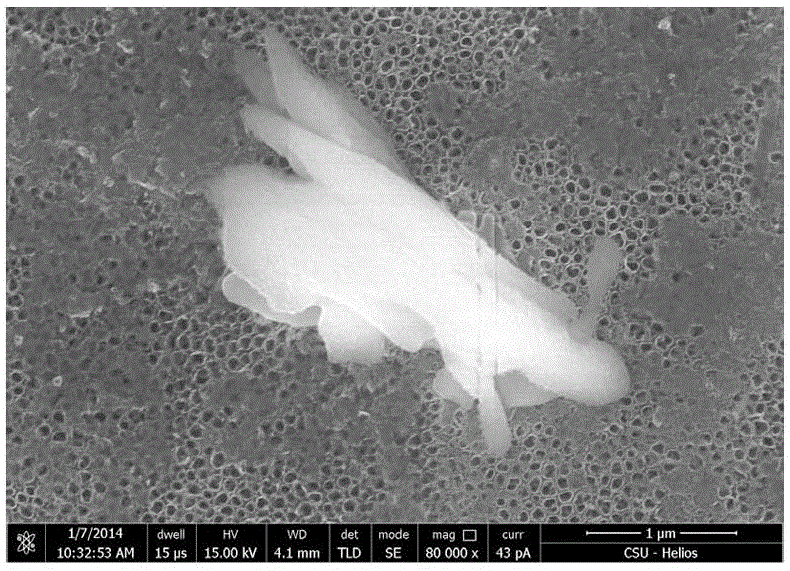Silane coupling agent modified titanium dioxide nanotube array material as well as preparation method and application thereof
A silane coupling agent, nanotube array technology, applied in the fields of nanomaterial modification and water treatment, can solve problems such as inability to solve binding problems, achieve excellent adsorption and degradation, improve hole-electron separation efficiency, and improve efficiency.
- Summary
- Abstract
- Description
- Claims
- Application Information
AI Technical Summary
Problems solved by technology
Method used
Image
Examples
Embodiment 1
[0028] Embodiment 1: the inquiry of reaction temperature
[0029] A kind of preparation method of silane coupling agent modified titanium dioxide nanotube array material of the present invention, take 4 titanium dioxide nanotube arrays, cut into 4cm 2 squares, respectively, into four 50ml beakers, add 20ml of toluene, silane coupling agent KH-570 and 1ml of glacial acetic acid, the mass of silane coupling agent KH-570 accounts for 5% of the sum of the mass of KH-570 and toluene ( That is, KH-570 forms a KH-570 solution with a mass fraction of 5wt% in 20ml of toluene), adjust it to pH=4 with w=5% acetic acid, shake it well, place it in a water bath heating device, and measure the reaction accurately with a thermometer The temperature of the system was adjusted to 50°C, 60°C, 70°C, and 80°C respectively. After reacting for 6 hours, the titanium piece was taken out and washed three times with acetone. The modified catalyst was used to degrade tetrabromodiphenyl ether and reduce C...
Embodiment 2
[0041] Embodiment 2: Exploration of reaction time
[0042] Using the preparation method of the silane coupling agent of the present invention to modify the titanium dioxide nanotube array material, take 6 titanium dioxide nanotube arrays (prepared by the method in Example 1), and cut them into 4cm 2 The squares are transferred into six 50ml beakers respectively, and 20ml of toluene, KH-570 and 1ml of glacial acetic acid are added. The mass of KH-570 accounts for 5% of the sum of the mass of KH-570 and toluene, adjusted with w=5% acetic acid to pH = 4, shake well, place in a water bath heating device, adjust the temperature to 50°C, react for 0.5h, 1h, 2h, 4h, 6h, and 8h respectively, take out the titanium sheet, and then wash it three times with acetone. The modified catalyst was used in the experiments of degrading tetrabromodiphenyl ether and reducing Cu(II) ions, and the optimal condition was the one with the highest degradation efficiency.
[0043] In the above preparatio...
Embodiment 3
[0044] Embodiment 3: Exploration of dosage of silane coupling agent
[0045] Using the preparation method of the silane coupling agent of the present invention to modify the titanium dioxide nanotube array material, take 5 titanium dioxide nanotube arrays (prepared by the method in Example 1), and cut them into 4cm 2 Move the squares into five 50ml beakers, add 20ml of toluene and 1ml of glacial acetic acid, add different amounts of KH-570 to the five beakers, so that the mass fraction of KH-570 in 20ml of toluene is 0.1 %, 1%, 5%, 10%, 20% KH-570 solution, adjust to pH=4 with w=5% acetic acid, shake well, place on heating plate, adjust temperature to 50°C, react for 8 hours, The titanium piece was taken out and washed three times with acetone. The modified catalyst was used in the experiments of degrading tetrabromodiphenyl ether and reducing Cu(II) ions. The optimum condition was taken as the one with the highest degradation efficiency.
[0046] In the above preparation, it...
PUM
| Property | Measurement | Unit |
|---|---|---|
| clearance rate | aaaaa | aaaaa |
Abstract
Description
Claims
Application Information
 Login to View More
Login to View More - R&D
- Intellectual Property
- Life Sciences
- Materials
- Tech Scout
- Unparalleled Data Quality
- Higher Quality Content
- 60% Fewer Hallucinations
Browse by: Latest US Patents, China's latest patents, Technical Efficacy Thesaurus, Application Domain, Technology Topic, Popular Technical Reports.
© 2025 PatSnap. All rights reserved.Legal|Privacy policy|Modern Slavery Act Transparency Statement|Sitemap|About US| Contact US: help@patsnap.com


